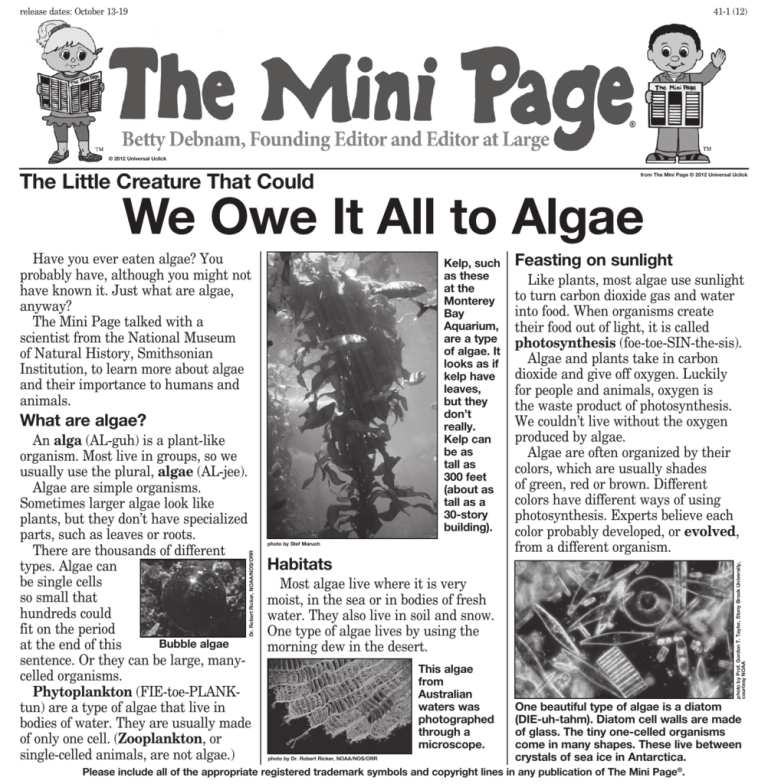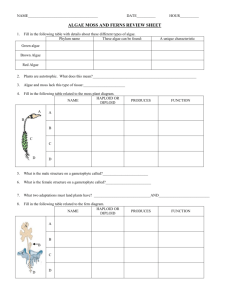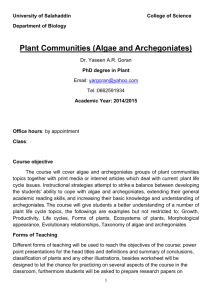
release dates: October 13-19
41-1 (12)
© 2012 Universal Uclick
The Little Creature That Could
from The Mini Page © 2012 Universal Uclick
We Owe It All to Algae
Kelp, such
as these
at the
Monterey
Bay
Aquarium,
are a type
of algae. It
looks as if
kelp have
leaves,
but they
don’t
really.
Kelp can
be as
tall as
300 feet
(about as
tall as a
30-story
building).
What are algae?
Dr. Robert Ricker, NOAA/NOS/ORR
An alga (AL-guh) is a plant-like
organism. Most live in groups, so we
usually use the plural, algae (AL-jee).
Algae are simple organisms.
Sometimes larger algae look like
plants, but they don’t have specialized
parts, such as leaves or roots.
There are thousands of different
types. Algae can
be single cells
so small that
hundreds could
fit on the period
Bubble algae
at the end of this
sentence. Or they can be large, manycelled organisms.
Phytoplankton (FIE-toe-PLANKtun) are a type of algae that live in
bodies of water. They are usually made
of only one cell. (Zooplankton, or
single-celled animals, are not algae.)
photo by Stef Maruch
Habitats
Feasting on sunlight
Like plants, most algae use sunlight
to turn carbon dioxide gas and water
into food. When organisms create
their food out of light, it is called
photosynthesis (foe-toe-SIN-the-sis).
Algae and plants take in carbon
dioxide and give off oxygen. Luckily
for people and animals, oxygen is
the waste product of photosynthesis.
We couldn’t live without the oxygen
produced by algae.
Algae are often organized by their
colors, which are usually shades
of green, red or brown. Different
colors have different ways of using
photosynthesis. Experts believe each
color probably developed, or evolved,
from a different organism.
photo by Prof. Gordon T. Taylor, Stony Brook University,
courtesy NOAA
Have you ever eaten algae? You
probably have, although you might not
have known it. Just what are algae,
anyway?
The Mini Page talked with a
scientist from the National Museum
of Natural History, Smithsonian
Institution, to learn more about algae
and their importance to humans and
animals.
Most algae live where it is very
moist, in the sea or in bodies of fresh
water. They also live in soil and snow.
One type of algae lives by using the
morning dew in the desert.
This algae
from
Australian
waters was
photographed
through a
microscope.
photo by Dr. Robert Ricker, NOAA/NOS/ORR
One beautiful type of algae is a diatom
(DIE-uh-tahm). Diatom cell walls are made
of glass. The tiny one-celled organisms
come in many shapes. These live between
crystals of sea ice in Antarctica.
Please include all of the appropriate registered trademark symbols and copyright lines in any publication of The Mini Page®.
®
41-2 (12); release dates: October 13-19
from The Mini Page © 2012 Universal Uclick
A Friend Indeed
These red algae
are a type of
seaweed from
the waters off of
Hawaii.
photo by Eric Guinter
Algae have been on Earth for more
than 1.6 billion years. Early algae
existed when there was hardly any
oxygen in the air. Over time, they
produced so much oxygen waste that
it changed the atmosphere. They put
enough oxygen into the air that
animals and people could breathe.
Without algae, none of us would be
here.
Plants also produce oxygen. But
algae were producing oxygen more
than a billion years before plants
even existed.
The algae in the ocean are
responsible for more than half of
all the oxygen we breathe today.
Some experts believe they may have
produced as much as 85 percent of
the oxygen in our atmosphere.
photo courtesy NURC/UNCW and
NOAA/FGBNMS
Creating the air we breathe
This green
grape algae
grows in
the Gulf of
Mexico.
Trapping carbon dioxide
Algae also help our atmosphere
by trapping carbon dioxide and
taking it out of the air. Carbon
dioxide is poisonous to people and
animals. It also traps the heat in our
atmosphere, warming the planet.
Plants also take carbon dioxide
from the atmosphere. When plants
are burned or they decay, they
release the carbon dioxide they had
pulled in. In some cases, it may take
100 years for the carbon dioxide to
return to the atmosphere.
But after algae die, their trapped
carbon dioxide sinks to the bottom of
the ocean. It could be 1 million years
before it returns to our atmosphere.
This helps slow global warming.
from The Mini Page © 2012 Universal Uclick
Ready Resources
The Mini Page provides ideas for websites,
books or other resources that will help you learn
more about this week’s topics.
On the Web:
• sciencenewsforkids.org/2010/05/the-algae-invasion-2
• seaweed.ie
• youtube.com/watch?v=JYB5529hDPI
• dailymotion.com/video/x5hxin_jean-michel-cousteau-oceanadventur_tech
At the library:
• “Life in a Kelp Forest” by Mary Jo Rhodes and David Hall
• “Beneath the Waves: Exploring the Hidden World of the Kelp
Forest” by Norbert Wu
Dining on algae
Algae are a super-important food
source. Sea animals, from tiny onecelled zooplankton to giant whales,
all depend on algae for most of their
food.
Humans eat algae too. Seaweed, a
type of algae, is an important part of
Asian food. It is in everything from
bread to sushi.
You may be eating algae without
realizing it. Kelp and other types
of algae are used as thickeners in
foods such as cheese,
pudding, chocolate
milk, orange juice
and soup. Algae keep
ice cream smooth
and help get rid of
ice crystals. They can
also be found in products such as
toothpaste and pet food.
Check the ingredient list on some
of the foods in your house. If you see
“agar,” “alginate” or “carrageenan,” it
means there are algae in the product.
from The Mini Page © 2012 Universal Uclick
Brown
Bassetews
try ’n
The N d’s
find
Houn
Words that remind us of algae are hidden in the block below. Some
words are hidden backward or diagonally. See if you can find: AIR,
ATMOSPHERE, BLUE, CARBON, CELL, CORAL, DIATOM, DIOXIDE,
FERTILIZER, FOOD, FUEL, KELP, LIGHT, ONE, ORGANISM, OXYGEN,
PLANKTON, RED, SEA, SEAWEED, SEWAGE, SUN, TIDE, WATER.
TM
Algae are
small but
mighty!
Algae
C
O
R
G
A
N
I
S
M
D
E
O
A
I
R
N
E
L
E
F
L
N
N
K
O
U
E
E
T
O
L
E
R
B
L
U
W
E
I
O
M
E
R
B
F
A
G
V
D
D
T
A
E
R
E
A
L
D
E
A
C
R
E
S
W
A
E
N
W
N
E
Z
M
E
R
R
E
E
O
H
I
O
S
O
A
G
D
T
P
L
T
T
C
E
Y
I
K
S
I
A
H
P
S
X
X
N
O
T
Please include all of the appropriate registered trademark symbols and copyright lines in any publication of The Mini Page®.
I
G
L
N
O
O
A
M
R
D
I
E
U
L
I
L
T
E
K
L
K
S
D
D
P
A
F
®
41-3 (12); release dates: October 13-19
Mini Spy . . .
TM
TM
Mini Spy and Rookie Cookie are making and enjoying
sushi. See if you can find: • man in the moon
• snake
• letter B
• letter D • doughnut
• muffin
• strawberry • arrow
• word MINI
• kite
• letter H
• ruler
• pencil
• banana • ladder
• bell
Rookie Cookie’s Recipe
Crunchy Edamame
You’ll need:
• 1 (16-ounce) bag frozen shelled edamame (soybeans)
• 1 tablespoon olive oil
• 1 tablespoon fresh lemon juice
• 1/3 cup grated parmesan cheese
• salt and pepper to taste
What to do:
1. Thaw frozen edamame by rinsing with cold water in a large colander.
2. Dry edamame with paper towels; place in a 9-by-13-inch baking dish.
3. Blend olive oil with lemon juice; pour over edamame.
4. Sprinkle cheese evenly over the soybeans; salt and pepper to taste.
5. Bake in a 400-degree oven for 15 minutes until cheese melts.
You will need an adult’s help with this recipe.
from The Mini Page © 2012 Universal Uclick
Meet Tim Burton
photo by Leah Gallo, © Disney Enterprises
Inc. All Rights Reserved
Tim Burton is a writer, director
and producer. He recently remade
an earlier film of his, the Disney
movie “Frankenweenie.”
Tim is famous for his movies,
including “Charlie and the
Chocolate Factory,” “Mars
Attacks!” and the remake of “The
Planet of the Apes.” He co-wrote
and produced “The Nightmare Before Christmas.”
Tim, 57, was born in Burbank, Calif. He liked to draw cartoons
when he was a child and won a prize for a poster he drew against
littering when he was in the ninth grade. He went to a college of
art and majored in animation. He was hired as an animator by
Disney right after college and helped animate movies such as “The
Fox and the Hound” and “The Black Cauldron.”from The Mini Page © 2012 Universal Uclick
from The Mini Page © 2012 Universal Uclick
!
The Mini Page®
W
E
N The Mini Page’s popular series of issues about each
Book of States
state is collected here in a 156-page softcover book.
Conveniently spiral-bound for ease of use, this invaluable
resource contains A-to-Z facts about each state, along
with the District of Columbia. Illustrated with colorful
photographs and art, and complete with updated
information, The Mini Page Book of States will be a
favorite in classrooms and homes for years to come.
To order, send $15.99 ($19.99 Canada) plus $5 postage and
handling for each copy. Make check or money order (U.S.
funds only) payable to Universal Uclick. Send to The Mini
Page Book of States, Universal Uclick, P.O. Box 6814,
Leawood, KS 66206. Or call toll-free 800-591-2097 or go
to www.smartwarehousing.com.
Please send ______ copies of The Mini Page Book of States
(Item #0-7407-8549-4) at $20.99 each, total cost. (Bulk discount information
available upon request.)
Name: _____________________________________________
Address: ____________________________________________
City: ______________________________________________
State: __________________________ Zip: ________________
from The Mini Page © 2012 Universal Uclick
TM
All the following jokes have something in common.
Can you guess the common theme or category?
Stanley: Where do spooky creatures go to learn?
Susan: A s-ghoul!
Sam: What do future bankers love about
circle time at school?
Stuart: Show and teller!
Sunny: What is a thermometer’s purpose at
school?
Steve: To earn a degree!
Please include all of the appropriate registered trademark symbols and copyright lines in any publication of The Mini Page®.
®
41-4 (12); release dates: October 13-19
from The Mini Page © 2012 Universal Uclick
The Many Faces of Algae
Out of control
photo courtesy NOAA
This “red tide,” or “algal bloom,” in the
Gulf of Mexico is a type of algae super
growth. Red tides can occur naturally, but
are often fueled by pollution. They can be
poisonous, or toxic.
Algae often form partnerships,
or symbiotic (sim-BEE-aht-ic)
relationships, with other organisms.
For example, lichen (LI-kuhn) is
formed by a partnership with a
fungus and algae.
The colors of
photo © OriginOil, Inc.
A scientist checks an algae sample at
OriginOil Inc. The blue and red colors in
the tank take the place of the sunlight
needed for photosynthesis.
photo courtesy Florida Keys National Marine Sanctuary
hard coral are
caused by algae
living inside the
bodies of the
coral animals. If
the algae leave
the coral, the
coral will die.
Super creature
Besides being a major food
source, experts believe algae could
be an important source of fuel and
fertilizer. They could also be used to
clean up sewage.
Just as animals store extra food
as fat, algae store extra food as oil.
Researchers hope they can use algae
oil as a biofuel. For example, the U.S.
Navy is experimenting with using a
mixture of algae oil and animal fat to
fuel its ships and aircraft.
If algae are put into a tank full
This leafy green algae lives in the Gulf of
of sewage, they can “eat” much
Mexico.
of the harmful waste. The algae
growing in the sewage can then be
The Mini Page thanks Barrett Brooks,
fed to livestock. They can clean the
National Museum of Natural History,
environment and feed animals at the Smithsonian Institution, for help with this
issue.
same time.
For years, people have been
Look through your newspaper for ads of
gathering algae from the shore and
products that might contain algae.
feeding them to livestock or using
Next week, The Mini Page is about maple
them as fertilizer.
trees.
photo courtesy NURC/UNCW and NOAA/FGBNMS
Sometimes algae can cause
problems for us. They need certain
minerals to help them grow. If there
are a lot of these minerals in the
water, algae grow like crazy.
Sometimes algae’s wild growth is
caused by pollution such as sewage
runoff. Algae love the extra nutrients
found in animal or human waste.
If there are too many algae in an
area, they can strip the oxygen from
the surrounding water. Overall,
algae do produce more oxygen than
they use. But at night, when there
is no sun, they can take in so much
oxygen that there is not enough for
fish to breathe. Also, when algae
die, the process of decay uses a lot of
oxygen.
Large groups of algae can block
sunlight from reaching plants living
in the water. Also, certain types of
algae produce poison that can kill
fish or make shellfish poisonous to
eat. It isn’t safe for people either.
Partnerships
The Mini Page Staff
Betty Debnam - Founding Editor and Editor at Large Lisa Tarry - Managing Editor Lucy Lien - Associate Editor Wendy Daley - Artist
Please include all of the appropriate registered trademark symbols and copyright lines in any publication of The Mini Page®.
Read all
about algae
photo courtesy NURC/UNCW
and NOAA/FGBNMS
in
®
Distributed by Universal Uclick
Appearing in your
­newspaper on ______.
from The Mini Page
© 2012 Universal Uclick
(Note to Editor: Above is cameraready, one column-by-31/2-inch ad
promoting Issue 41.)
release dates: October 13-19
41-5 (12)
®
from The Mini Page © 2012 Universal Uclick
Standards Spotlight:
We Owe It All to Algae
Mini Page activities meet many state and national educational standards. Each
week we ­identify standards that relate to The Mini Page’s content and offer
activities that will help your students reach them.
This week’s standard:
• Students understand the characteristics and life cycles of organisms.
(Science: Life Science)
Activities:
1. Write the letters A-L-G-A-E down the side of a piece of paper. Paste a
newspaper word that starts with each letter and describes algae next to it.
2. Divide a piece of paper into two columns. In one, list the ways algae help us.
In the other, list problems algae can cause.
3. Do an algae hunt in your house. Find as many food and health items you can
that contain algae.
4. How are these important to algae: (a) oxygen, (b) carbon dioxide, (c) livestock,
and (d) sewage?
5. Research the type of algae found near where you live. What does this type
do? How is it helpful?
(standards by Dr. Sherrye D. Garrett, Texas A&M University-Corpus Christi)
(Note to Editor: Above is the Standards for Issue 41.)
TM
from The Mini Page © 2012 Universal Uclick
Supersport: Maurice Jones-Drew
Height: 5-7 Weight: 210 Hometown: Antioch, Calif.
Forget his height. Measure Maurice Jones-Drew by
his might.
Darting, dashing and smashing, the Jacksonville
Jaguars’ stocky running back has wrecked opposing
defenses the last few years. He led the NFL in rushing
last season with a career-best 1,606 yards and earned
All-Pro honors for the third time.
A star at UCLA in college, Jones-Drew gets around off the field
as well. He has played a role on a television comedy. He also hosts a
radio show and has been supportive of multiple charities.
Now, with another season under way, he’s back on the field, ready
to rumble again.
(Note to Editor: Above is copy block for Page 3, Issue 41, to be used in
place of ad if desired.)
Please include all of the appropriate registered trademark symbols and copyright lines in any publication of The Mini Page®.










